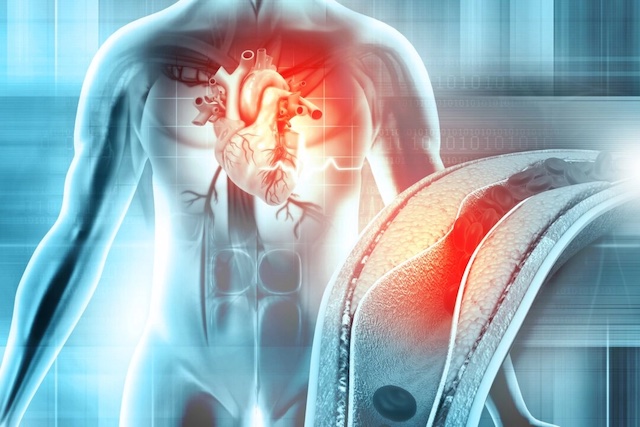Some doctors recommend comprehensive treatment strategies that address the cause of disease over the ‘silver bullet’ approach of targeting symptoms.
 Columbia University Irving Medical Center researchers have discovered that smooth muscle cells (SMC) in arteries can behave like cancer cells, worsening atherosclerosis. Their study, published in Circulation, suggests that anticancer drugs could help prevent heart attacks and strokes caused by this condition.
Columbia University Irving Medical Center researchers have discovered that smooth muscle cells (SMC) in arteries can behave like cancer cells, worsening atherosclerosis. Their study, published in Circulation, suggests that anticancer drugs could help prevent heart attacks and strokes caused by this condition.
Atherosclerosis, the buildup of fatty plaques in arteries, is a leading cause of cardiovascular disease. Despite treatments such as statins, the prevalence of atherosclerosis-related diseases continues to rise. Research published in Frontiers in Cardiovascular Medicine states that atherosclerosis “has now surpassed communicable diseases to become the world’s most prevalent killer.”
“Atherosclerosis has been known as a chronic inflammatory disease for several decades,” Dr. Huize Pan, lead author and assistant professor of Medicine at Vanderbilt University, told The Epoch Times. He explained that the new findings offer a fresh perspective by viewing the disease through a cancer lens, potentially identifying new drug targets for prevention and treatment.
~ Cancer-Like Behavior of Artery Cells ~
Using advanced techniques on mice and tissue samples from atherosclerosis patients, the researchers aimed to understand how smooth muscle cells in the arteries begin to behave like cancer cells.
The researchers observed significant DNA damage and rapid cell growth in both human and mouse arteries affected by atherosclerosis.
“DNA damage is one of the major features of cancer,” Dr. Pan said.
These SMCs displayed several cancer-like traits—they multiplied rapidly, resisted cell death, invaded surrounding areas, and showed increased DNA damage. This DNA damage, typically absent in healthy arteries, was common in atherosclerotic plaques and appeared to worsen the disease.
“The cells stay inside existing plaques, which makes us think that they behave mostly like benign tumor cells, but more work needs to be done in humans and animal models to address this hypothesis,” Dr. Muredach Reilly, co-author of the study, stated in a press release.
~ Using Cancer Drugs for Heart Disease ~
To test their theory, the researchers treated atherosclerotic mice with niraparib, a cancer drug that targets DNA-damaged cells. Dr. Pan explained that niraparib, a PARP inhibitor, helps prevent smooth muscle cells in the arteries from transforming into other cell types. Additionally, it slows the rapid growth of SMCs and the cells derived from them.
The treatment significantly reduced the size of the plaques and made them more stable. Stable plaques are less likely to rupture, which can prevent serious cardiovascular events such as heart attacks and strokes. Unstable plaques can break apart and block blood flow, leading to these life-threatening conditions.
The study authors suggest that their research opens the door for further investigation into the cancer-like behavior of atherosclerosis. By identifying specific mutations and understanding DNA damage in patients, doctors could develop personalized therapies.
According to the authors, the broader concept, called “athero-oncology,” suggests that cancer treatments might revolutionize the treatment of atherosclerosis.
“If considering implications for human disease treatment, more pre-clinical work needs to be done, such as testing for side effects, deeper studies on how it works in atherosclerosis, and whether it influences other diseases,” Dr. Pan said.
“Our findings provide a new dimension to understand the disease pathogenesis from the tumor/cancer perspective, which is important for understanding the nature of the disease and figuring out druggable molecules for the prevention and treatment of atherosclerosis.”
~ Downsides of Cancer Drugs for the Heart ~
Many cancer treatments have been linked to heart disease, a significant concern for patients undergoing chemotherapy and other therapies. A 2023 Frontiers in Cardiovascular Medicine study reports that “some anticancer drugs can cause coronary atherosclerotic heart disease.”
Dr. Pan acknowledges that, stating, “It’s true that some chemotherapy drugs used in cancer treatment can increase the risk of heart problems.” However, he also notes that some drugs have been “reported to reduce the complications” of heart disease. Dr. Pan’s study “suggests that niraparib may have potential benefits for preventing and treating atherosclerosis.”
Dr. Nathan Goodyear, an integrative physician at Williams Cancer Institute, raises concerns about the side effects of niraparib, which may include bleeding, blood clotting problems, gastrointestinal issues, headaches, and fatigue. He suggests that a more integrative approach, combining natural and conventional therapies, could optimize treatment while reducing side effects. He points to the potential use of natural PARP inhibitors such as quercetin, curcumin, and chlorogenic acid.
~ No Magic Bullet ~
“There are a lot of similarities between atherosclerosis and cancer because, of course, they both are diseases of aging,” Dr. Goodyear told The Epoch Times in an email.
He highlighted the inherent complexity of diseases such as atherosclerosis and cancer, suggesting that seeking a “magic bullet” is overly simplistic.
“In atherosclerosis, as in cancer, niraparib is looking for the magic bullet,” he noted, underscoring the need for comprehensive treatment strategies that address the underlying causes of disease rather than merely its symptoms.
Dr. Goodyear argued that the traditional “war on cancer” approach, initiated by President Richard Nixon in 1971, is flawed.
“Going to war on cancer is going to war on the body,” he said. “It does not work in cancer, and it will not work in atherosclerosis.”
Dr. Goodyear urged a paradigm shift in medical thinking to combat complex diseases such as atherosclerosis.
“We can no longer think sequentially or in a 1:1 treatment strategy. We must even think outside the disease box,” he said.
“Though the innovative thinking in this study does provide hope, the innovation in thinking must continue to redirect the purpose and the outcome. The goal is not to treat disease but to heal from disease.”
Written by Sheramy Tsai for Epoch Health ~ June 25, 2024
